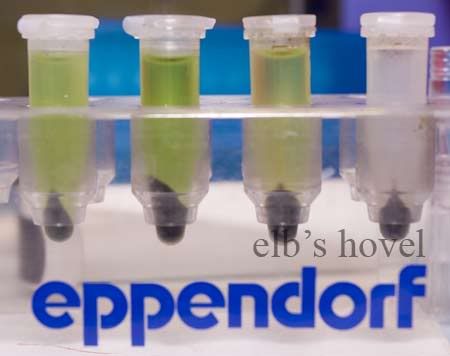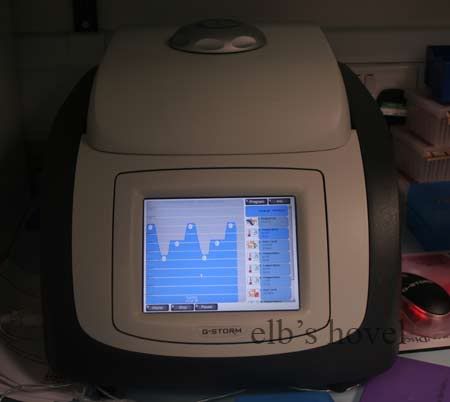Polymerase Chain Reaction
Ever wondered how forensic scientists can work with so little DNA? They can swab your cheeks, take a few epithelial cells from a crime scene, and produce miracles out of it. Or how archaelogists work with insects preserved in amber. Or how people like me work with bacteria. Or my sheep, as Elaine fondly refers to them.

The mutated bacteria glimmering in radioactive waste. Oh wait, that's just chlorophyll from the algae which it grew alongside with. Yes, the algal chlorophyll got smashed out of their cell walls by centrifuging at 13 000 times gravity. Ow.
The answer lies in a tidy little process called polymerase chain reaction. Basically, tiny parts (or huge parts) of DNA become exponentially amplified through the clever use of biotechnology (the inventor of the technique received little compensation while his company ratted away hundreds of millions, bastards. *makes note to self to become the self-employed discoverer of the solution of the IgG problem*)
Basically, as you all should know, every living thing has a genetic code stored away somewhere which is called DNA. What a rude shock I got, one of the questions thrown at me during my presentation was 'what is DNA?', and I was totally not expecting such a simple question I fumbled for a minute.
Anyway, parts of your DNA are common to other humans (duh), and some parts are unique to you alone (duh, it makes you you). So basically, little 'probes' called primers are designed to attach to either edge of the common, or conserved, DNA, allowing for the unique sections, or variable, regions of the DNA to be copied. So we have a small (or large, depending) segment of DNA to be copied and which is flanked by the primers, that act as start/ stop signals.
But before this, we need to extract the DNA from the cells. To cut the long story short, we subject the cells to inhumane treatments of pummeling to death with microbeads, chemical attack by surfactants to tear the cell membranes apart, or repeated freezing/ thawing. Ouch.
So yes now we have the bits and pieces of DNA, we have the primers, now we need to be able to copy the bits in between the two primers. To achieve this, we use a combination of different temperatures and an enzyme which binds artificially added nucleotides (remember in school, you learnt that DNA is made from four letters? A T G and C) together, doubling the number of DNA with the bits we are interested in.

The 'CSI machine' (thermocycle machine) at work. Photograph courtesy of my air conditioned lab. Not like it makes much of a difference lately since its cold again, but it was bliss when temperatures were 35 celsius outside.
This cycle is typically repeated 30 times. So you can imagine, if we had one single strand of DNA, that would grow to 2^29 the number of DNA strands. And that's just one DNA piece. Imagine if there were a couple of hundred of DNA to start with (subject to available free nucleotides, of course).
After the process is complete, we get to play with mutagens as well! But that's another story for another day.

The mutated bacteria glimmering in radioactive waste. Oh wait, that's just chlorophyll from the algae which it grew alongside with. Yes, the algal chlorophyll got smashed out of their cell walls by centrifuging at 13 000 times gravity. Ow.
The answer lies in a tidy little process called polymerase chain reaction. Basically, tiny parts (or huge parts) of DNA become exponentially amplified through the clever use of biotechnology (the inventor of the technique received little compensation while his company ratted away hundreds of millions, bastards. *makes note to self to become the self-employed discoverer of the solution of the IgG problem*)
Basically, as you all should know, every living thing has a genetic code stored away somewhere which is called DNA. What a rude shock I got, one of the questions thrown at me during my presentation was 'what is DNA?', and I was totally not expecting such a simple question I fumbled for a minute.
Anyway, parts of your DNA are common to other humans (duh), and some parts are unique to you alone (duh, it makes you you). So basically, little 'probes' called primers are designed to attach to either edge of the common, or conserved, DNA, allowing for the unique sections, or variable, regions of the DNA to be copied. So we have a small (or large, depending) segment of DNA to be copied and which is flanked by the primers, that act as start/ stop signals.
But before this, we need to extract the DNA from the cells. To cut the long story short, we subject the cells to inhumane treatments of pummeling to death with microbeads, chemical attack by surfactants to tear the cell membranes apart, or repeated freezing/ thawing. Ouch.
So yes now we have the bits and pieces of DNA, we have the primers, now we need to be able to copy the bits in between the two primers. To achieve this, we use a combination of different temperatures and an enzyme which binds artificially added nucleotides (remember in school, you learnt that DNA is made from four letters? A T G and C) together, doubling the number of DNA with the bits we are interested in.

The 'CSI machine' (thermocycle machine) at work. Photograph courtesy of my air conditioned lab. Not like it makes much of a difference lately since its cold again, but it was bliss when temperatures were 35 celsius outside.
This cycle is typically repeated 30 times. So you can imagine, if we had one single strand of DNA, that would grow to 2^29 the number of DNA strands. And that's just one DNA piece. Imagine if there were a couple of hundred of DNA to start with (subject to available free nucleotides, of course).
After the process is complete, we get to play with mutagens as well! But that's another story for another day.
0 Comments:
Post a Comment
<< Home